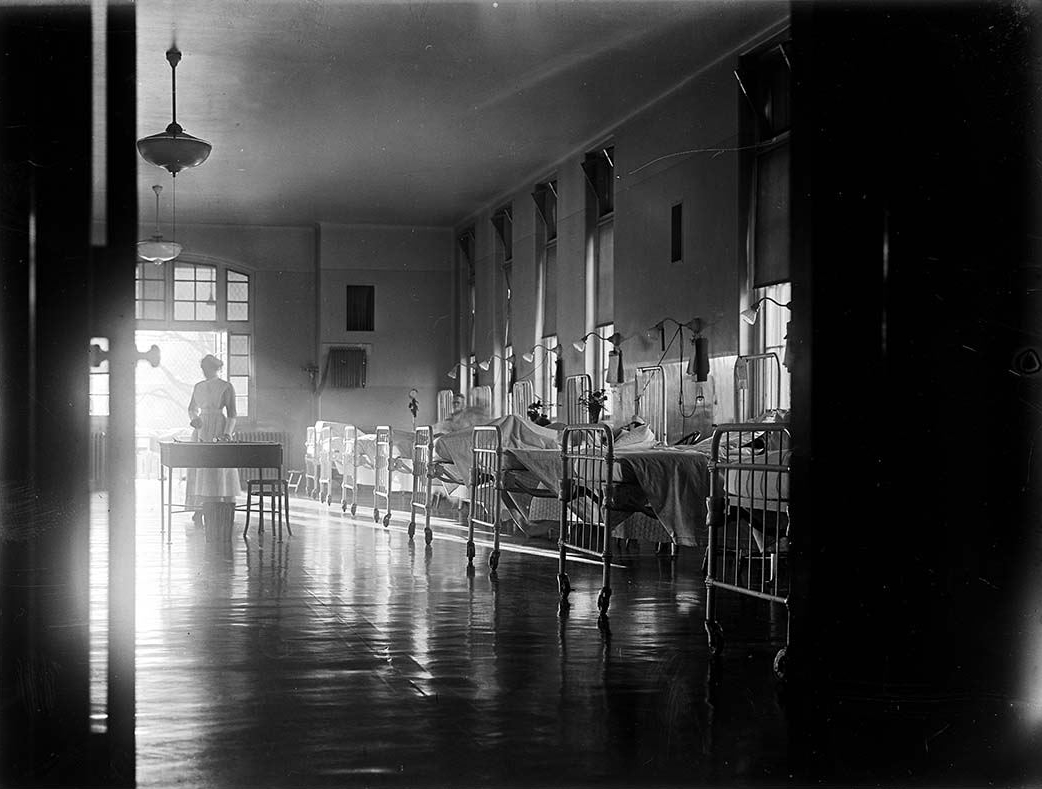Toilers of the Night, Part II
The People Who Don’t Go to Bed Until Sunrise
From The Toronto World, May 9, 1884
 Interior, Toronto General Hospital, 1913. CTA F1231-it207b
Interior, Toronto General Hospital, 1913. CTA F1231-it207b
The majority of men working in city bake-houses are not, strictly speaking, employed all night. About 3 a.m., or a little later, as the printers begin to straggle out from the newspaper offices, the baker’s working-day begins.
When he quit work the previous afternoon, he left behind him the material on which to start in the morning. This is known as the “sponge,” a light brown pasty substance, composed of potatoes, flour and water. This has to be worked by hand and by a mixer, an oblong iron frame which is made to revolve in the midst of the sticky mass.The majority of men working in city bake-houses are not, strictly speaking, employed all night. About 3 a.m., or a little later, as the printers begin to straggle out from the newspaper offices, the baker’s working-day begins.
After being thoroughly mixed and slapped about it is heated, and when reduced to a temperature of 80 degrees the yeast is added. More flour and water brings the “sponge” into the condition known as dough. When this stage is reached, contrary to the general impression, there is usually no further kneading.
The dough is spread out on a table and weighed into lumps the size of the loaves required. These are sometimes placed in drawers below the table until ready for the oven. Or the dough may be cut into the requisite sizes in a large trough. This work is usually carried on in a long low cellar under the salesroom.
In some cases, where the ventilation is not good, or the premises small, the heat is very trying, but where the cellar is ample the temperature is seldom found to be very oppressive. Only three bakeries in Toronto use the steam process. When the hands go to work at the hour specified above, the bread is usually turned out in shape for consumption by 8 a.m.
There is one building in Toronto where the inmates are almost as busily employed by night as by day. Passing the general hospital on Gerrard street at any time after dark you will notice that although the war windows show but a faint light throughout the length of the building, there are fast following flashes and sometimes a transitory burst of illuminations inside.
If you enter the institution, ascending the broad stairway to the second floor, you will be struck by the stillness that reigns throughout the corridors, and the almost ghost-like tread of the flitting figures that pass and repass one another in the dim gaslight. If they converse at all, what they have to say is uttered in whispers, and the only sound likely to reach your ear is an occasional groan or subdued cry from some sleepless sufferer.
Enter one of the wards and you shall find yourself in a big whitewashed hall, without other furniture than a long row of little iron beds on either side, with a chair and table adjoining to each. Here the night nurse is, or ought to be, in constant attendance, never removing herself so far as to be out of call by any of the patients who may desire her services.
Every second window or so, if the night be not too cold, is thrown open, for the authorities are great believers in the virtues of ventilation. The beds are placed four or five feet apart, but so narrow are they that one involuntarily wonders how the occupant, especially if he be sick and restless, manages to keep himself poised all night in the exact centre of his straw mattress.
About a score of nurses are on duty every night at the hospital. They enter the ward at 7 p.m. and remain there until the same hour next morning. The real amount of work to be done during the twelve hours is not excessive. Medicine has to be given to the different patients, at various hours throughout the night, and the nurse has to attend to the dressing of the less important hurts of her charges.
She is also provided with a small book, in which she is supposed to enter particulars regarding those patients whose state is supposed to be critical. In some cases she has to take their temperature at given times. Between 5 and 7 in the morning she airs and arranges the beds for the day.
Few of the nurses at present in the hospital look forward to spending a lifetime in that institution. After two years’ apprenticeship they graduate from there as full-fledged, certificated nurses. Their wages during the period of training are little more than nominal, but they are provided with working uniforms, consisting of a neat white cap, apron and plain-fitting dress, and are, of course, boarded free of cost.
The two years over, most of the nurses hold themselves in readiness for engagements in private families, a business at which they can earn $10 a week, or even more. The majority of them are young women under thirty-five, the novices working under the supervision of an experienced nurse during the first month or so of their training. Their appearance is invariably neat and clean, and their cheerful yet quiet attire has a very pleasing effect when viewed in a sick room.
Besides the superintendent, Dr. O’Rielly, there are always four or five house surgeons on hand at the hospital. These are called upon to do duty at all hours of the night. The dressing of wounds, fractures and sores, constitutes a large portion of their work. If a patient be in great pain, and it is judged necessary that he should be enabled to sleep, the doctor is at his side with a morphine pill or ready to administer a hypodermic injection of the drug. Of course, in case of a sudden change or a crisis in the patient’s condition, he is usually called for; but his presence is seldom deemed necessary when the signs of death are unmistakably visible, unless the circumstances are such as to require his soothing ministrations.
When a death occurs in any of the wards at night, two or more able-bodied men, employees of the hospital, are summoned from below, and in an inconceivably short time the remains are decently pinned up in a sheet and conveyed in a litter to the dead house.
The only time when the quiet is really broken is when the great doorbell rings, after the ambulance has rattled up with its load of suffering mortality. Then there is something like a flutter in the hall; the doctor is summoned to superintend the work of removing the man from the vehicle, and to make a rough diagnosis of his injuries or disease.
The patient is placed on a litter, the physician indicates the ward to which he is to be conveyed, and two stalwart men tramp upstairs bearing the prostrate figure between them. In a few seconds the sufferer is placed in a clean, cool bed, the doctor makes a more thorough examination, and the operation, if one be necessary, is carried out beneath a sudden blaze of gas-light. ♦
◊ You may also wish to read Toilers in the Night, Part I.






